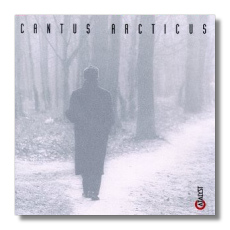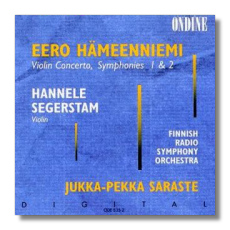
The Internet's Premier Classical Music Source
Related Links
- Latest Reviews
- More Reviews
-
By Composer
-
Collections
DVD & Blu-ray
Books
Concert Reviews
Articles/Interviews
Software
Audio
Search Amazon
Recommended Links
Site News
 CD Review
CD Review
Modern Finns

Einojuhani Rautavaara
- Cantus Arcticus (1972)
- String Quartet #4 (1975)
- Symphony #5 (1988)
Sirius String Quartet
(Laura Seaton, Mary Rowell, violins;
Ron Lawrence, viola; Mary Wooten, cello)
Leipzig Radio Symphony Orchestra/Max Pommer
Catalyst 62671-2 DDD 70:59


Eero Hämeenniemi
- Symphony #1
- Symphony #2
- Violin Concerto *
* Hannele Segerstam, violin
Finnish Radio Symphony Orchestra/Jukka-Pekka Saraste
Ondine ODE835-2 DDD 64:24
"A complex and contradictory figure whose works cannot be neatly categorized in stylistic terms" – so Finnish composer Kalevi Aho has described his countryman Einojuhani Rautavaara (b. 1928). This new Catalyst CD demonstrates Rautavaara's diversity well. It opens with the composer's best-known work, the Cantus Arcticus, or "Concerto for Birds and Orchestra." Perhaps a more accurate title would be "Concerto for Bird Voices and Orchestra, and it should be specified that the songs are on tape, lest performers and audiences anticipate a messily hazardous quarter-hour in the concert hall. Rautavaara takes the taped cries of wild birds from the arctic regions, speeds them up, slows them down, and supports them with a lush, sometimes almost Technicolor orchestral accompaniment. The effect is desolate and chilly in spite of the opulent colors – think of the northern lights. Cantus Arcticus can seem either gimmicky or profound depending on your mood.
The other works on the Catalyst CD are less approachable. The single-movement symphony opens with a series of impressive, shattering crescendos, but the next thirty minutes are a dense landscape with few signposts. The string quartet is in three movements, and like the symphony, it moves within fairly narrow boundaries. Paradoxically, both works speak a more adventurous musical language than the Cantus Arcticus, but perhaps a less distinctive one.
The orchestral works were originally released on the Ondine label (BMG Classics has pulled off some creative licensing here); only the quartet has been newly-recorded. I don't know why Pommer and Leipzig have such an affinity for Finnish music, but they do, as is also demonstrated by their Aho disc on Ondine. Catalyst's presentation is extremely attractive.
If you pronounce the names of both of these composers well, it's better than having braces. Eero Hämeenniemi (b. 1951) is a new name to me, and I think that his Ondine CD is his first to be distributed in the United States. Even though he is more than twenty years younger than Rautavaara, Hämeenniemi's absolute music looks farther back – I was thinking of Alban Berg as I heard each of these three large works. The First Symphony (1982-83) is relatively brief and is based on a chord of two perfect fifths stacked upon each other and separated by a major third. The Second Symphony (1988) is in three movements and makes much use of solo instruments complementing and combatting the full orchestra. The Violin Concerto (1990-1991) also is in three movements and also pits soloists against each other, and against the orchestra. Hameeniemi's music is less distinctive than that of his Kalevi Aho and Aulis Sallinen, to name to other notable Finns, but I'm not ready to say that there's less to it just yet. This is the sort of difficult listening that CDs were made for.
As usual, Ondine's sound is clear and impactful, and the performances seem right, particularly given Hameeniemi's long-standing collaboration with this orchestra and conductor. The composer's notes are not especially helpful, but I gather from them that he's man who prefers to have his music speak for itself. For now at least, it doesn't.
Copyright © 1996, Raymond Tuttle




















